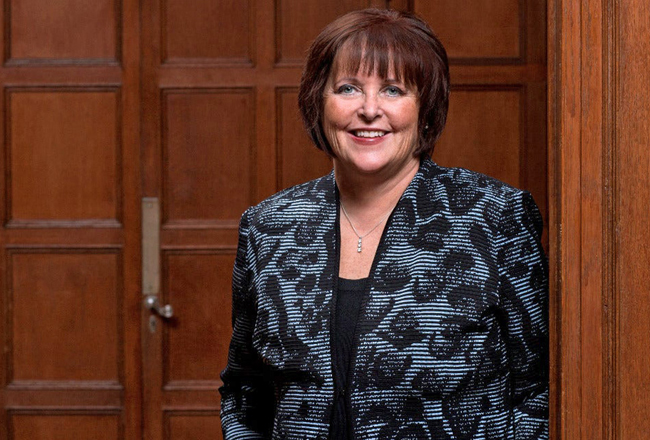Synchrony’s Margaret Keane reflects on her C-suite journey
On April 1, Margaret Keane stepped down as CEO of Stamford-headquartered Synchrony after seven years at the helm, moving to the role of executive chairwoman of the company”™s board of directors. During her tenure as chief executive, Keane was among the powerful and prominent women in the U.S. financial services industry.

However, in the recent Fairfield Dolan Lecture presented online by Fairfield University, Keane recalled that her path to the upper echelons of the financial services world began in a modest setting.
“I grew up in a big family in Queens, New York, and was attending St. John”™s University,” she said. “I actually got the job through the career office at St. John”™s, because they were paying $5.50 an hour for you to make collection calls.”
Keane recalled the call center experience was crucial for her professional development.
“I learned very early on about hard work,” she said. “I”™m a big believer in hard work. You can learn a lot of things about a person by every job that they have ”” just the responsibility of showing up, doing their job, being there on time, not calling in sick, all those things.”
But she also pointed out that the nature of her job taught her the importance of bringing a holistic approach to work that is often emotionally difficult.
“That has never left me: The idea of empathy, of people falling down and needing help to pick themselves up, people making mistakes, maybe overextending,” she said.
“I”™ve always had this sense of empathy, really making sure you”™re helping the customer and I think that”™s played through my entire career. Understanding where customers are challenged and making sure that we”™re helping them is something that is in the forefront of my thinking.”
Keane”™s journey in the financial services world took her to Citibank”™s trainee programming, which began a 16-year career at the company before switching to General Electric Capital. Looking back, she expressed gratitude to Citi, noting “there were not a lot of women in big roles and I actually had a very big role there,” but said she left because her work-life balance was awry and “I wasn”™t feeling it anymore.”
The move from Citi in New York to GE Capital in Connecticut came with one jolting culture shock.
“I initially worked in Danbury and I didn”™t realize they were all Red Sox fans up there,” she said, with a laugh, adding that her ascension through the GE Capital ranks was the result of “hard work, my ability to get things done. I”™m one of those people that people know I”™ll get it done.”
When GE Capital spun off Synchrony as a separate company in 2014, Keane became one of only two women running an independently traded U.S. bank valued at more than $10 billion ”” the other was Beth Mooney at KeyCorp. Looking back, Keane theorized her ability to rise in a profession where very few women hold chief executive roles was based on her ability to “viewed differently than the rest of the crowd.”
“I think that”™s really pivotal,” she said. “I think women lead differently ”” we saw through the pandemic where countries led by women seemed to have less issues, and I think there”™s a couple of reasons why. I do think women have less ego ”” it”™s not to say we don”™t have one, but I do think we are solution-oriented, so we want to fix the problem and we”™ll turn to the most knowledgeable person around and say, ”˜What do you think?”™
“I”™ve seen men sometimes think that they knew all the answers,” she continued. “To be honest, the further you move up in an organization, the less you know, and the people around you are the ones who know what”™s happening in the operation. You have to trust and rely on those people to really tell you what”™s going on.”
Still, Keane isn”™t absenting herself from her career success, adding, “I”™ve always had great confidence in myself. It”™s the one area that I have to say, every woman needs to continue to work on, which is that little voice in their head that says, ”˜How do I get here, I don”™t think I belong here? I”™m not the smartest person in the room.”™ That little voice is the voice that I think holds women back sometimesw and you”™ve just got to keep fighting through that voice.”
As for the next generation of executives moving up through the ranks, Keane advocated building and becoming part of a support network that encompasses all demographics within a corporate environment.
“I wouldn”™t have gotten where I got to if I didn”™t have men supporting me along the way,” she said. “We need to create an environment where everyone”™s participating, and the more inclusive your organization, the better the innovation and ideas are going to be. And if you create that, as a foundation of your company, it is going to open up more opportunity for the company.”